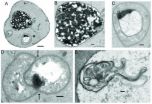(Press-News.org) Princeton University researchers have observed a self-degradation response to the antidepressant Zoloft in yeast cells that could help provide new answers to lingering questions among scientists about how antidepressants work, as well as support the idea that depression is not solely linked to the neurotransmitter serotonin.
In findings published in the journal PLoS ONE, researchers based in the lab of Ethan Perlstein, an associate research scholar in Princeton's Lewis-Sigler Institute for Integrative Genomics and senior lecturer in molecular biology, report that sertraline — trademarked as Zoloft — accumulated in the internal membranes of baker's yeast cells.
This buildup caused a swelling and sharp curvature in the membranes of vesicles, bubble-like cell components with a hand in cell metabolism, movement and energy storage. The vesicles then went into autophagy, a protective response in which cells recycle excess or damaged membrane.
But yeast cells lack serotonin, which is the primary target of antidepressants, Perlstein said. By observing a reaction to sertraline in an organism that does not contain the drug's conventional target, Perlstein and his co-authors have found significant evidence suggesting that antidepressants engage in pharmacological activity beyond regulating serotonin. Perlstein worked with co-first authors Jingqui Chen and Daniel Korostyshevsky, as well as Sean Lee, all three senior research specialists in Perlstein's lab.
[Images can be seen at http://www.princeton.edu/main/news/archive/S33/52/72E11. To obtain high-res images, contact Princeton science writer Morgan Kelly, (609) 258-5729, mgnkelly@princeton.edu]
Although antidepressants are known to regulate serotonin, it is not completely understood how antidepressants interact with the body's brain cells and what effect, if any, this activity has on treating depression, Perlstein said. Antidepressant accumulation has been observed in the membranes of human cells, the researchers report, but is considered benign.
If, however, the membrane curvature the researchers found has therapeutic significance in treating depression, then the cell membrane could present an additional target for next-generation antidepressants.
More immediately, Perlstein said, the activity of the drug in a serotonin-free organism supports existing research suggesting that depression might also be linked to diminished secretions of brain-derived neurotrophic factor (BDNF), a protein that regulates brain-cell growth.
Perlstein explains his findings as follows:
"The key finding of this paper is that the antidepressant sertraline/Zoloft accumulates within an organism lacking serotonin and induces autophagy, which is a protective mechanism cells use to recycle excess or damaged cell membrane. Specifically, we observed distortions, bulging and buckling in the membrane layer of vesicles inside cells treated with sertraline.
"We saw these effects in the yeast species Saccharomyces cerevisiae, or baker's yeast. Despite it being a simple, single-cell organism, the basic cellular 'plumbing' of yeast has been preserved by evolution in more complex organisms, including humans.
"In fact, the gene networks that we found modify vesicle formation in yeast cells in response to sertraline also exist in human cells, specifically neurons. Vesicle formation heavily influences the ability of neuronal synapses — the tiny gapped connections between nerve cells — to package neurotransmitters and prepare them for use in nerve-cell communication.
"Our finding that sertraline affects vesicle formation suggests a more expansive view of antidepressant function than is currently accepted.
"Dominant now is the monoamine hypothesis of antidepressant function, which was originally formulated in the 1960s and 1970s. It states that depression is the result of a chemical imbalance of neurotransmitters in the brain that may be corrected by artificially increasing the levels of serotonin, or other monoamine neurotransmitters, in the synapses. Sertraline belongs to a class of drugs called selective serotonin reuptake inhibitors (SSRI) that are thought to block the function of specific proteins that normally decrease serotonin levels in the synapses.
"However, the monoamine hypothesis fails to account for several key clinical observations of antidepressant activity, notably the lag time between the start of antidepressant treatment in patients and the onset of relief. Moreover, the monoamine hypothesis cannot explain the unexpected biological activity of antidepressants in simple organisms that lack serotonin such as baker's yeast.
"The work out of my lab captures a specific non-serotonin-based biological reaction to an SSRI. Granted, the synaptic serotonin transporter is one site where these drugs interact, but we show that's likely not all they do. These drugs have multiple effects on various targets in the cell — and one of the targets might be cell membranes themselves.
"In addition, our work provides some grounding for the neurotrophic hypothesis of depression, which states that the loss of neural connectivity in specific brain regions such as the hippocampus may actually be the root of depression. The neurotrophic hypothesis fills in many of the gaps of the monoamine hypothesis, including the therapeutic time lag. Since the 1990s, neuroscientists have known that chronic, extended antidepressant treatment can result in the proliferation of brain cells, possibly via a mechanism that involves the growth protein BDNF.
"Altogether, our work suggests that the serotonin-based theory might be an oversimplification and that the cause of depression is not a closed story.
"In my lab, future research will aim to integrate the multiple, interwoven strands that make up the totality of antidepressant pharmacology — including but also beyond serotonin — and translate this knowledge into better antidepressants and diagnostic tools for depression."
INFORMATION:
This research was published online April 18 in PLoS ONE and was supported by the Lewis-Sigler Institute.
Information for news media
Perlstein is available to discuss his research with interested members of the news media and can be contacted at eperlste@princeton.edu, or through Princeton University science writer Morgan Kelly at 609-258-5729 or mgnkelly@princeton.edu.
Yeast cell reaction to Zoloft suggests alternative cause, drug target for depression
2012-04-25
ELSE PRESS RELEASES FROM THIS DATE:
Pod corn develops leaves in the inflorescences
2012-04-25
This press release is available in German.
In a variant of maize known as pod corn, or tunicate maize, the maize kernels on the cob are not 'naked' but covered by long membranous husks known as glumes. According to scientists from the Max Planck Institute for Plant Breeding Research in Cologne and Friedrich Schiller University in Jena, this variant arises from the activity of a leaf gene in the maize cob that is not usually active there. Thus, pod corn is not a wild ancestor of maize, but a mutant that forms leaves in the wrong place.
Pod corn has a spectacular ...
Rhode Island Hospital researcher: Broadening bipolar disorder criteria is a bad idea
2012-04-25
PROVIDENCE, R.I. – A Rhode Island Hospital psychiatrist and researcher explains the negative impact of broadening the diagnostic criteria for bipolar disorder in the upcoming Diagnostic and Statistical Manual of Mental Disorders, Fifth Edition (DSM-5). In a newly published commentary in the Journal of Clinical Psychiatry, Mark Zimmerman, M.D., explains that lowering the diagnostic threshold for bipolar disorder will likely do more harm than good for patients.
As the debate continues over the revisions to DSM-IV, Zimmerman, the director of outpatient psychiatry at Rhode ...
Dietary changes help some children with ADHD
2012-04-25
Together with child and adolescent psychiatrists, researchers from the University of Copenhagen have just completed an extensive report which reviews the studies which have been done so far on the significance of diet for children and young people with ADHD. The report shows that there are potential benefits in changing the diets of children with ADHD, but that key knowledge in the area is still lacking.
The comprehensive report covers the scientific literature on the significance of diet for children with ADHD:
"Our conclusion is that more research is required in the ...
CAM therapy combined with conventional medical care may improve treatment of lower back pain
2012-04-25
New Rochelle, NY, April 23, 2012— Nearly 8 of 10 Americans will experience lower back pain at some time in their lives. Persistent low back pain is a common, incapacitating, costly, and difficult to treat condition. Many patients might benefit significantly from an individualized, multidisciplinary, team-based model of care that includes access to licensed complementary care practitioners (e.g., chiropractors, massage therapists, and acupuncturists) in addition to conventional care providers, as demonstrated in a study published in The Journal of Alternative and Complementary ...
On-the-job deaths steady in Michigan; Number of burn injuries underreported
2012-04-25
EAST LANSING, Mich. — The rate of workplace deaths in Michigan remained steady in 2011, as 141 workers died on the job compared with 145 in 2010, according to an annual report from Michigan State University.
The construction industry had the most deaths at 24, while the agriculture industry had the second most at 22, according to the Michigan Fatality Assessment and Control Evaluation program, or MIFACE.
The program – administered by MSU's Division of Occupational and Environmental Medicine, part of the College of Human Medicine – investigates work-related deaths and ...
'Junk DNA' can sense viral infection
2012-04-25
Once considered unimportant "junk DNA," scientists have learned that non-coding RNA (ncRNA) — RNA molecules that do not translate into proteins — play a crucial role in cellular function. Mutations in ncRNA are associated with a number of conditions, such as cancer, autism, and Alzheimer's disease.
Now, through the use of "deep sequencing," a technology used to sequence the genetic materials of the human genome, Dr. Noam Shomron of Tel Aviv University's Sackler Faculty of Medicine has discovered that when infected with a virus, ncRNA gives off biological signals that ...
Carrentals.co.uk Reports Surge in Car Hire Bookings Ahead of 2012 Olympics
2012-04-25
Demand for car hire around the 2012 Olympic Games has surged recently according to leading online car hire comparator Carrentals.co.uk. The website is advising people to book rentals well in advance if they want to get plenty of choice and availability of cars this coming summer.
Carrentals.co.uk reports that rental bookings for between 20 July and 12 August are up by around four times on the same period in 2011, with 40% of total bookings around the Olympics set for collection at Gatwick or Heathrow airport.
July 20 and 21 will see the most cars being collected as ...
Molecular probes identify changes in fibronectin that may lead to disease
2012-04-25
Fibronectin plays a major role in wound healing and embryonic development. The protein, which is located in the extracellular matrix of cells, has also been linked to pathological conditions including cancer and fibrosis.
During physiological processes, fibronectin fibers are believed to experience mechanical forces that strain the fibers and cause dramatic structural modifications that change their biological activity. While understanding the role of fibronectin strain events in development and disease progression is becoming increasingly important, detecting and interrogating ...
Norwich Dentist Offers Patient Education on New Website
2012-04-25
Dr. Mark Young, Norwich dentist, is pleased to be able to offer an in-depth patient education library to his patients as a part of his practice's new comprehensive website. The library is designed to give his patients the information necessary to maintain good oral health and avoid costly dental problems.
"I am happy that our new dental website is able to help educate our patients. I have always believed that the more educated a patient is about dental topics, the better chance they have to maintain good oral health over their lifetimes. I hope our patients will ...
McLean Dentist Reaches Out to Patients Through Social Media and New Blog
2012-04-25
Dr. Rouben Yedigarian, McLean dentist, is pleased to be joining the social media world by creating Facebook and Twitter pages for his patients to follow. In addition, the McLean, VA dentist also has created a dentistry blog that can be found on his practice's new comprehensive website.
"We are excited to be able to enter the world of social media with our new Twitter and Facebook pages. I believe that interaction between us and our patients is a very positive thing and our social media presence will allow us to interact like never before. I hope all of our patients ...



